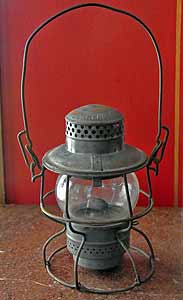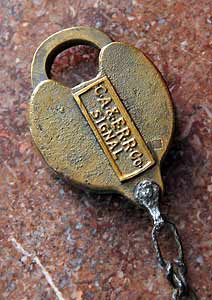







 A westbound train at Ardmore Avenue in Villa Park (Glen Brewer photograph).
A westbound train at Ardmore Avenue in Villa Park (Glen Brewer photograph).
My wife, Emily, went to York High School in Elmhurst, Illinois for the first two and a half years (from the fall of 1944 to part way into her junior year-March of 1947). Her family then moved to Oak Park, several miles to the east, where she finished high school in 1948. That is where we first met. During her years at York High, Emily worked, after classes were over for the day, at two dry cleaning stores. Both were part of a small Chicago area chain called Suburban Cleaners. Often she worked at the one in her hometown of Villa Park, sometimes in a town a few miles to the west, in Lombard. She did receiving and bagging, and also was given the responsibility of closing the store when she left to go home for dinner. These were the latter years of World War II and everything was in short supply. Customers had to bring in their own metal hangers. If they had none, they would have to buy one for 5¢.
There was an electric commuter train that ran daily from two cities situated on the Fox River (about 40 miles west of Chicago) to downtown Chicago. The cities were Aurora and Elgin, The official name of the railroad was the Chicago, Aurora and Elgin Railroad. Many in the area, however, dubbed it the Roarin' Elgin. The train stopped at many suburban stations along that route. When Emily worked in the Lombard store, she took the Roarin' Elgin train to Villa Park and then walked home.
One afternoon, after closing the store in Lombard later than usual, Em ran to the Roarin' Elgin train station to return to Villa Park, only to find that the train was already in the station and passengers were boarding. The cleaners was located a few blocks north of the tracks. Boarding could only be done on the south side of the tracks. She was concerned that if she missed that train, she would arrive home much too late, and the family would be worried. There was only one thing to do. Emily got down and crawled under one of the cars between the sets of wheels-one steel track at a time-to the other side, then tried to find an open door to board. The doors were already closed and departure was imminent. Em climbed up the two or three open steps to the outside of the closed door, turned around and sat on the top step, hanging on to the stair railing for dear life and continuing the praying she had started when crawling under the car! Reaching Ardmore Ave. in Villa Park a few minutes later, she simply stepped down, waited for the train to depart, and went home for dinner.
Why didn't Emily ever tell me about this before? Her crawling under the train occurred in 1944 or early 1945, since it was still during the war years. She was 15 or 16. It took about 65 years after the event and 62 years after I met her before she told me. It simply came out during one casual evening conversation in 2009-very matter of fact, as if it were no big deal. I didn't have the impression that she had been hiding it or avoiding telling me up to that time. I couldn't believe my ears! "Why didn't you ever tell me about this before?" I asked. "It was one of the big events of your growing-up years!" I just got a shrug in return. And just when you think, after 57 years of marriage, you've heard all the stories about your spouse's youth!
To those who entered our family during the 60s or later, this seemed even more unbelievable because they never saw Em when she was not walking with difficulty, using a walker and occasionally a wheelchair, or permanently wheelchair bound. It's hard to visualize the person they had seen move only with significant disability actually getting down on the ground and crawling under a train.






Today much of the CA&E right-of-way is the Illinois Prairie Path, a 55-mile-long biking, hiking, jogging, equestrian, and nature trail in Cook, DuPage and Kane Counties.
Both Villa Park stations are still there. The Villa Avenue station is now the home of the Villa Park Historical Society Museum.

Villa Park Historical Society Museum, Villa Park, Illinois
DuPage County Historical Museum, Wheaton, Illinois
The Chicago, Aurora & Elgin; The Roaring Elgin on Facebook
Seventeen of the interurban cars and one line car were preserved:

Where to see them today:
Electric City Trolley Museum, Scranton, Pennsylvania: Cincinnati steel car 453.
Fox Valley Trolley Museum: Wooden cars 20, 316, 317, St. Louis steel car 458 and line car 11.
Illinois Railway Museum, Union Illinois: Wooden cars 36, 308, 309, 319, 321 Pullman steel car 409, Cincinnati steel car 431, and St. Louis cars 451 and 460.
Midwest Old Thrashers (Midwest Electric Railway), Mt. Pleasant, Iowa: Wooden Car 320.
Rockhill Trolley Museum, Rockhill Furnace, Pennsylvania: Wooden car 315
Seashore Trolley Museum, Kennebunkport, Maine: Wooden car 434.

The Great Third Rail, Central Electric Railfans' Association, 1961
Aurora 'N' Elgin, James D. Johnson, The Traction Orange Company, 1965
Sunset Lines, The Story of the Chicago Aurora & Elgin Railroad, 1 - Trackage, by Larry Plachno, Transportation Trails 1986
Sunset Lines, The Story of the Chicago Aurora & Elgin Railroad, 2 - History, by Larry Plachno, Transportation Trail 1989
The Living Legacy of the Chicago Aurora and Elgin, by Peter Weller and Fred Stark, WS Productions 2000
Aurora-Elgin Area: Street Cars & Interurbans: The Third Rail Line Chicago, Aurora & Elgin RR (Volume 3), by Hopkins Stolp Peffers, American Slide-Chart Corporation (1993)
Interurban Trains to Chicago Photo Archive, by John Kelly, Enthusiast Books (August 14, 2007)
Chicago, Aurora, and Elgin (DVD 44 minutes), Sunday River Productions
Also see Riding the Electroliner
Page 1 The 'Ror'n' Elgin as I remember it
Page 2 Wheaton (headquarters, shops, equipment and scrapping)
Page 3 Along the line (Elmhurst to Elgin after abandonment)
Page 4 Relics of the CA&E (this page)
Page 5 Newspaper clippings